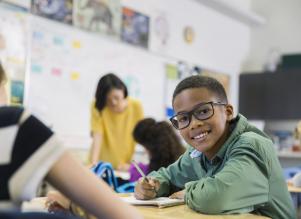12/15/2016
Combining Passion and Personalized Learning
Many people think implementing personalized learning in the classroom is an impossible feat given so many requirements and growing classrooms.
It’s not only possible, it makes students want to learn. Personalized learning involves tailoring material to the individual student’s passions and interests. This allows for a partnership to evolve between teacher and student wherein each has control over the learning process.
This sentiment is echoed by Corey Golla, Director of Curriculum and Learning at the Menomonee Falls School District in Wisconsin, in a 2016 Knowledge Works article: “Our vision of personalized learning includes the student voice at every level of the improvement process. Teachers work actively with students to establish a mission statement and classroom norms. With those items in place, students are engaged in each phase of the PDSA process, a part of continuous improvement that requires users to plan, do, study, and act.”
Who is the audience and what do they want to learn?
Even if a teacher is required to teach a lesson about the U.S. Constitution, for example, she can still incorporate personalized learning to tailor the assignment so it is relevant and interesting.
Students may gravitate toward different aspects of the Constitution, like freedom of speech, laws about interstate commerce, how to use the political system to pass legislation, or laws about discrimination. Combining areas of interest within the lesson (for example, freedom of speech) with a student’s passion outside of school (for example, music) is an excellent way to provide differentiated and engaging lessons.
A teacher could require her students to teach the rest of the class about a certain piece of the Constitution but allow them to relay that information in a variety of ways. Using the above examples of freedom of speech and music, a student may choose to write a song or a rap about the First Amendment.
Traditional vs. personalized learning
Try this experiment: Break students into two groups and prepare different lessons for each group. Use the same topic and learning objectives, but present the topic in two different ways.
-
Assignment 1:
Assignment 1 is a generic, everyday assignment. It’s not a bad assignment, but it is standard and somewhat expected. It most likely has a worksheet or two focused on all the skills necessary to master the concept, and a quiz at the end.
-
Assignment 2:
Assignment 2 is individualized to each student in the experimental group, including room for several interests. If the student likes oceanography, teach the same skill with this interest in mind—include math, reading, science, social studies, etc., but connect it all to the ocean. For example, you could discuss the math of population increase, ecology, and pollution management, or you could ask a student to create a first-person story from the perspective of ocean life for a literacy class. Don’t forget to make sure the skills being focused upon are the same as the ones being taught to the other group.
Take note of each group’s level of engagement, the time spent on the task, and the amount of work done during the lesson. At the end, have students report what they did and how they felt about it, and then reveal the results to the class. An experiment like this can show students how they can develop a love of learning and how that learning can be applied to things they value.
Personalized learning is the key to unlocking the passions inside of us all—adults and students alike. The more teachers learn about personalized learning and incorporate it into their classrooms, the more excited they’ll feel seeing students take an active role in their education. When done successfully, personalized learning becomes an upward spiral of success for everyone involved.


